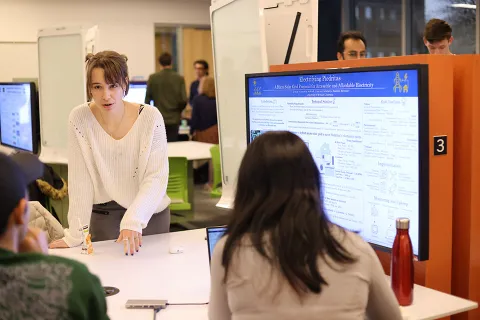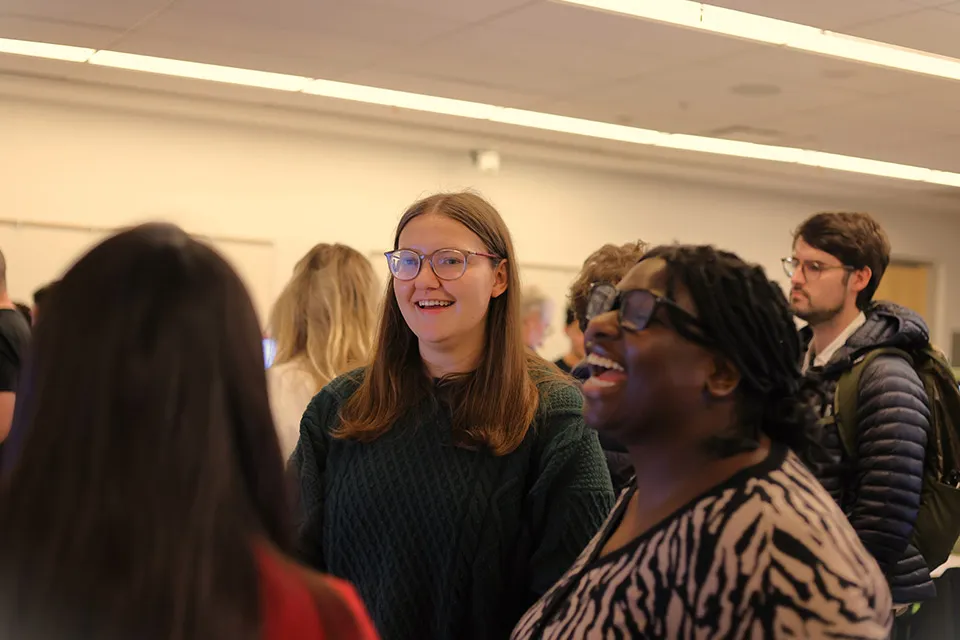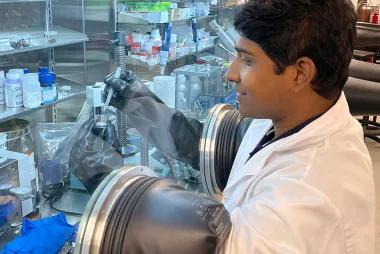Interdisciplinary UBC course trains future generation of humanitarian engineers

A unique new course on humanitarian engineering has been training engineering and arts students to tackle real-world humanitarian challenges.
Jointly offered by the Faculties of Applied Science and Arts, the course mixed engineering, political science and international relations students into design teams. Each team received a different problem from a partnering non-governmental organization (NGO), and were asked to propose a solution in a comprehensive project report.
“Solutions to real humanitarian challenges must, by necessity, be interdisciplinary if they are to be effective and sustainable,” said co-instructor Dr. Gabriel Potvin, an associate professor of teaching in chemical and biological engineering.
“This course is a rare opportunity for students to venture outside of disciplinary boundaries and work on real challenges in a more authentic environment than a traditional course. The result is a learning experience that is richer, more genuine and more directly applicable to real-world projects.”
Projects ranged from water treatment and sanitation issues to electrification and energy needs in countries as diverse as Chile, India and Peru. Teams were expected to consult regularly with their NGO partner and include socio-economic considerations in their report.
Developing interdisciplinary skillsets
To prepare teams for the challenge, students were first taught the key tools, strategies and constraints used within each discipline, to develop a better understanding for one another’s expertise.
Every class was also co-taught by Potvin and Dr. Jenny Peterson, an associate professor of teaching in political science, to model interdisciplinary dialogue and debate.
“Because every element of the course was worked on and agreed upon by both of us, we had to spend a lot of time explaining our rationale behind things to the other instructor, which was time consuming sometimes,” Peterson explained. “This brought to the surface disciplinary differences but also, on a more basic level, uncovered different preferences we had around teaching and class management.
“It could be frustrating at times, but ultimately made us better instructors. It meant we also understood students’ struggles within their interdisciplinary teams, but could also model how to work through those differences.”

This kind of teaching quickly reaped benefits within the class, with students from both disciplines expressing admiration for their peers’ skillsets.
“I really appreciated the emphasis arts students placed on identifying multiple factors influencing the community,” said Harishankar Krishnan, a fifth-year environmental engineering student. “By thinking critically, using various lenses, they were more adept at finding the root cause of a problem.
“My arts teammates were also quick to question existing policies for Indigenous communities and recommended changes throughout the project – something a lot of engineering students otherwise accept as ‘design requirements’.”
Fourth-year arts student Audrea Wang said, “While political science students tend to be good at big-picture goal setting, engineering students are very strong in the ‘how’; once it is clear what needs to be accomplished and avoided, engineers come up with ingenious ways of achieving these goals.
“As a political science student and young human rights advocate, I am rather wary of technological developments; there is a common narrative that the misuse of new technologies can cause devastating social impacts. However, interdisciplinary cooperation throughout this course has shown me the potential for technology to promote positive change.”
Students’ camaraderie was evident at an end-of-term poster presentation open to the UBC community, which garnered local media interest.

“Attendees couldn’t identify which students were from engineering and which from political science or international relations,” said Potvin. “We had engineers confidently discussing the political context of the locales in which their projects would be deployed, and arts students enthusiastically explaining why their team chose to use electromagnetic flow meters instead of mechanical ones in their designs.”
Community-oriented projects, community consultation
Krishnan, whose team designed a point-of-entry water treatment system for an Indigenous community in Lytton, B.C., praised the unique, interdisciplinary approach.
“Having professors from both arts and engineering made our class feel more like a conversation – sometimes a fun debate! – with frequent comparison between how humanitarian challenges could be interpreted. This kept everyone more open-minded.
“One of the main lessons I learned from this course is the importance of community-oriented projects and community consultation. While this can make humanitarian work challenging, almost all successful projects shared in this course became successes by working closely with communities.”
Peterson noted that the requirement to engage with NGO partners is part of what sets this course apart. “These weren't fictional projects, but real-life situations where NGOs could benefit from both technical advice, but also on how to engage with communities in ways that were sensitive to culture, power dynamics and economic systems.”
This emphasis on real-world projects and community consultation is the legacy of Andrew Sheroubi, a UBC chemical and biological engineering alum.
"Solutions to real humanitarian challenges must, by necessity, be interdisciplinary if they are to be effective and sustainable."
As a student, Sheroubi was inspired by an Engineers Without Borders speaker to apply his engineering knowledge to humanitarian settings. Lacking avenues to practice humanitarian engineering, he developed a student directed seminar for engineering students that ran in 2018, reaching out to NGOs for real-world problems students could tackle.
Sheroubi, who now works for Delco Water, expressed his delight with the interdisciplinary nature of this new course. “It’s surreal to see the course grow and evolve, and I’m impressed with what these teams have achieved. While there is still work that needs to be done on the NGO side to verify information and adjust solutions, these reports mark a fantastic start to address their challenges. Of note, I would have proposed similar solutions, and I have multiple years of experience in the field.”
Potvin and Peterson have a list of NGOs keen to work with students in the next iteration of the course, which runs again in September 2024.
“What becomes all the more important as humanity struggles to address some daunting societal and environmental challenges is that future leaders will need interdisciplinary fluency, communication and teamwork skills, and an ability to approach and analyze complex solutions,” said Potvin.
“This type of interdisciplinary education is essential to training the kind of engineers, political scientists and humanitarian workers that our world needs.”



